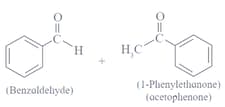Chemical Properties of aldehydes and ketones
Important Questions on Chemical Properties of aldehydes and ketones
Aldehydes are more reactive toward nucleophilic addition reactions than ketones. Explain.
Write a reaction showing the conversion of acetaldehyde into acetaldehyde dimethyl acetal.
What is the action of hydrazine on cyclopentanone in presence of in ethylene glycol?
Observe the following equation of the reaction of Tollens’ reagent with an aldehyde. How do we know that a redox reaction has taken place. Explain.
What is formalin?
Draw the structures of -dinitrophenylhydrazone of acetaldehyde.
Draw the structure of the imine formed in the reaction between -methylhexanal and ethyl amine.
Draw the structures of the semicarbazone of cyclohexanone.
Which is the reagent that oxidizes primary alcohols to only aldehydes and does not oxidize aldehydes further into carboxylic acid?
Write reaction showing aldol condensation of cyclohexanone.
Benzaldehyde does not show positive test with
Aldol condensation is
In the Wolf -Kishner reduction, alkyl aryl ketones are reduced to alkyl benzenes. During this change, ketones are first converted into
Can isobutyraldehyde undergo a Cannizzaro reaction? Explain.
Observe the following reaction.


Will this reaction give a mixture of products like a cross aldol reaction?
Write chemical reactions taking place when propan--ol is treated with iodine and sodium hydroxide.
When acetaldehyde Is treated with dilute the following reaction is observed.
Is this an addition reaction or condensation reaction?
When acetaldehyde Is treated with dilute the following reaction is observed.
Will there be another product formed during the same reaction ? (Deduce the answer by doing atomic audit of reactant and product)
When acetaldehyde Is treated with dilute the following reaction is observed.
What are the functional groups in the product?
Sodium bisulfite is sodium salt of sulfurous acid, write down its detailed bond structure.

